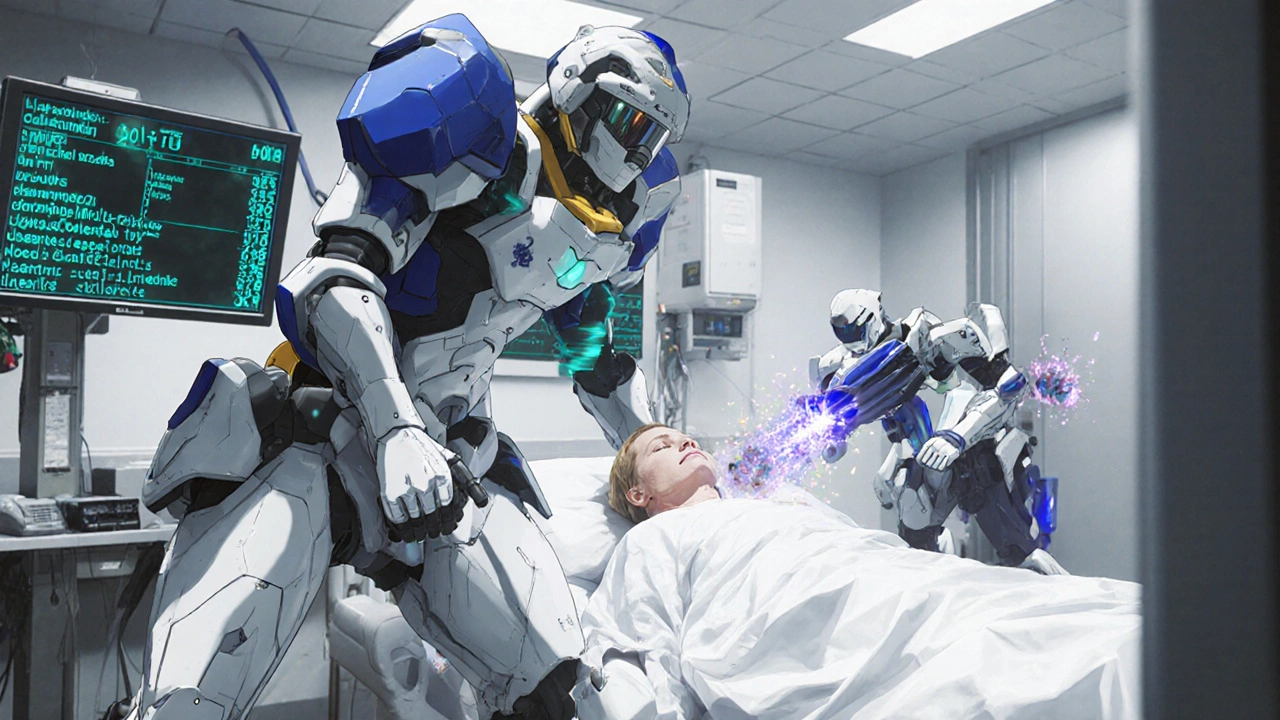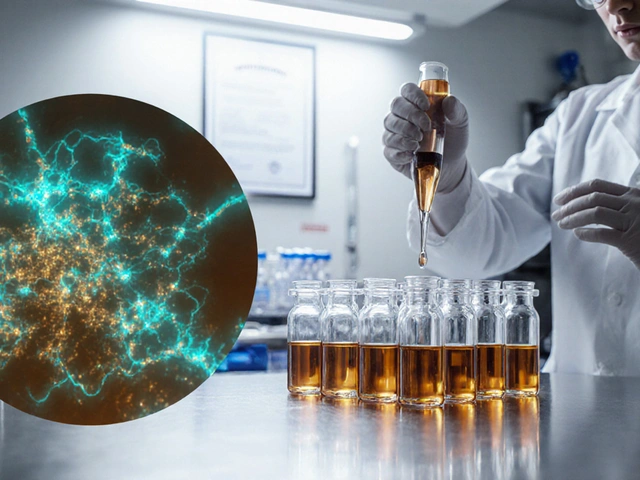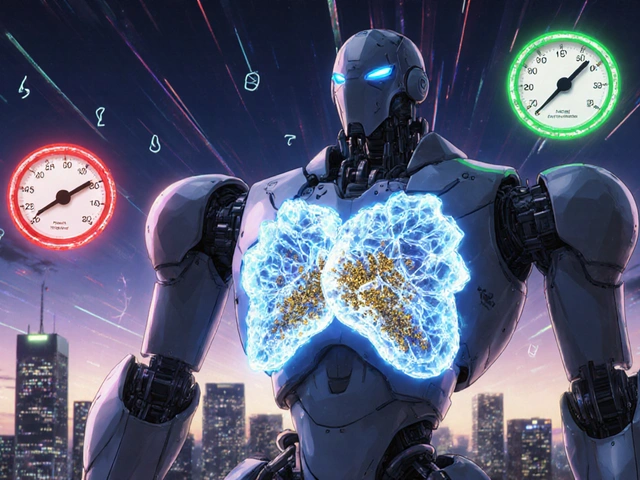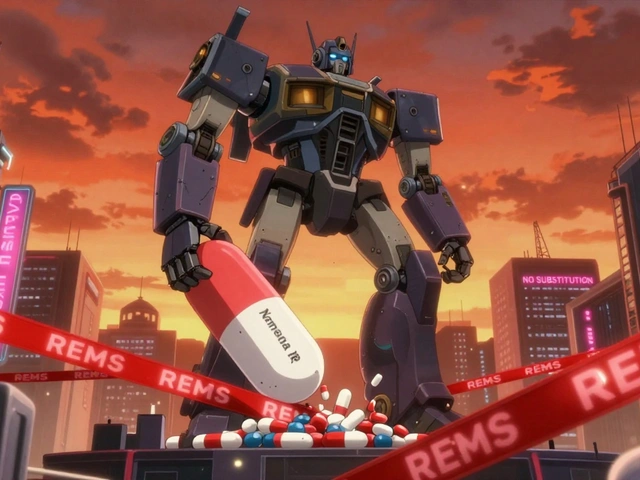Drug-Induced TTP Risk Assessment
Critical Risk Assessment
This tool helps identify potential drug-induced TTP. A platelet count below 50 × 10⁹/L after starting a new medication requires immediate medical attention.
Enter values to see your risk assessment
Drug‑induced Thrombotic Thrombocytopenic Purpura is a rare but life‑threatening reaction that occurs when certain medicines trigger the formation of tiny blood clots throughout the microvasculature. These clots use up platelets and shred red blood cells, leading to severe thrombocytopenia, hemolytic anemia, kidney injury, and neurologic confusion. If you or someone you know suddenly develops a platelet count under 50 × 10⁹/L after starting a new drug, think of drug‑induced TTP as a medical emergency.
What exactly is drug‑induced TTP?
The condition falls under the umbrella of thrombotic microangiopathies (TMAs). In the drug‑related form, two main mechanisms drive the clotting cascade:
- Immune‑mediated TTP - the drug acts like a trigger for antibodies that attack the metalloprotease ADAMTS13 only when the drug is present. The resulting ADAMTS13 activity drops below 10%, allowing ultra‑large von Willebrand factor (vWF) multimers to aggregate platelets.
- Dose‑dependent toxicity - cumulative exposure to drugs such as mitomycin C or cyclosporine directly injures endothelial cells, sparking clot formation without an antibody bridge.
Both paths lead to the classic pentad: thrombocytopenia, microangiopathic hemolytic anemia, renal dysfunction, neurologic symptoms, and fever. In practice, the full pentad appears in fewer than one‑third of cases, so a high index of suspicion is essential.
How does the body react? The role of ADAMTS13 and vWF
ADAMTS13 (a disintegrin and metalloproteinase with a thrombospondin type 1 motif, member 13) normally cleaves ultra‑large vWF multimers into harmless fragments. When ADAMTS13 is crippled - either by drug‑dependent antibodies or by toxic endothelial damage - those giant vWF strings remain intact, tethering platelets together in tiny vessels. The resulting microthrombi consume platelets (<150 × 10⁹/L, often <30 × 10⁹/L) and shear red cells, creating schistocytes on a peripheral smear.
Medications most often implicated
More than 300 drugs have been linked to TTP, but only a handful have strong, reproducible evidence. The table below summarizes the top offenders, their typical latency, and the prevailing mechanism.
| Drug | Typical onset (days) | Mechanism | Estimated risk per 10,000 prescriptions |
|---|---|---|---|
| Quinine (including tonic water) | 5-10 | Immune‑mediated | 12.3 |
| Clopidogrel | 7-14 | Immune‑mediated | 3.7 |
| Ticlopidine | 7-21 | Immune‑mediated | 6.2 |
| Mitomycin C | 180-365 (cumulative) | Dose‑dependent toxicity | 1.5-15 % in transplant patients |
| Cyclosporine | 90-180 (cumulative) | Dose‑dependent toxicity | 2.1 |
| TNF‑α inhibitors (adalimumab, golimumab) | 30-90 | Immune‑mediated (rare) | ~0.05 |
Note that over‑the‑counter quinine in bitter‑lemon tonic water accounts for about 23 % of all quinine‑related TTP cases, so a thorough medication history must include supplements and dietary products.
Spotting the emergency: clinical clues and lab findings
When drug‑induced TTP is suspected, the following features should trigger immediate action:
- Platelet count < 50 × 10⁹/L (often < 20 × 10⁹/L in immune‑mediated cases)
- Hemolytic anemia: schistocytes on smear, LDH > 500 U/L, undetectable haptoglobin
- Acute kidney injury: rising creatinine, oliguria
- Neurologic changes: confusion, seizures, focal deficits
- Fever or mild jaundice (optional)
Crucially, do NOT wait for ADAMTS13 results before starting treatment. The test can take 24-72 hours, while plasma exchange should begin within 4-8 hours of clinical suspicion.

Diagnostic algorithm in practice
- Take a detailed medication timeline covering prescription drugs, OTC products, and supplements for the past 3 months.
- Obtain a complete blood count, peripheral smear, LDH, bilirubin, creatinine, and urinalysis.
- Send ADAMTS13 activity and inhibitor testing (if available) - but treat empirically first.
- Rule out other TMAs (e.g., atypical HUS, disseminated intravascular coagulation, heparin‑induced thrombocytopenia).
- Identify the likely culprit drug based on timing and known associations.
- Document the case for pharmacovigilance reporting (FAERS, VigiBase, national systems).
First‑line management: stop the drug and start plasma exchange
Immediate discontinuation of the offending medication is the most critical step. For immune‑mediated TTP, the standard of care includes:
- Therapeutic plasma exchange (TPE) using fresh frozen plasma as replacement, 1.5 × patient plasma volume daily until platelets rise above 150 × 10⁹/L for two consecutive days.
- Adjunctive corticosteroids (e.g., methylprednisolone 1 mg/kg) to dampen antibody production.
- Caplacizumab (anti‑vWF nanobody) in centers where affordable - it shortens time to platelet normalization by ~50 % (TITAN trial).
For dose‑dependent toxicity, the emphasis shifts to drug withdrawal, supportive renal care (dialysis if needed), and careful monitoring - plasma exchange offers limited benefit because ADAMTS13 is usually not severely depleted.
Prognosis, follow‑up, and long‑term considerations
Even with prompt therapy, mortality remains 10-20 %. Survivors often face lingering fatigue, neurocognitive deficits, or chronic kidney disease. Recommended follow‑up includes:
- Weekly CBC for the first month, then monthly for six months.
- ADAMTS13 activity retesting at three months to assess recovery.
- Patient education on avoiding the offending drug and related cross‑reactive agents.
- Reporting the event to national pharmacovigilance databases to help refine safety signals.

Prevention: what clinicians and patients can do
Pre‑emptive steps dramatically reduce risk:
- Screen new prescriptions for known high‑risk agents, especially in patients with prior TMA or autoimmune disorders.
- Ask specifically about quinine‑containing beverages, herbal supplements, and over‑the‑counter antiplatelet drugs.
- Educate patients on early warning signs (sudden bruising, dark urine, confusion) and advise immediate medical attention.
- Utilize electronic health record alerts for drugs with black‑box warnings for TTP (e.g., quinine, ticlopidine).
Rapid comparison: Immune‑mediated vs. Dose‑dependent drug‑induced TTP
| Feature | Immune‑mediated | Dose‑dependent toxicity |
|---|---|---|
| Typical latency | 5-14 days after first exposure | Months of cumulative dosing |
| ADAMTS13 activity | <10 % (often <5 %) | Usually >30 % |
| Platelet nadir | Median 15 × 10⁹/L | Median 30-45 × 10⁹/L |
| Response to plasma exchange | High (>80 % platelet recovery) | Modest or none |
| Key culprits | Quinine, clopidogrel, ticlopidine, TNF‑α inhibitors | Mitomycin C, cyclosporine, gemcitabine |
What to do if you suspect drug‑induced TTP
- Call emergency medical services - time is critical.
- Inform the team about the recent drug exposure (include dose, duration, and any over‑the‑counter items).
- Insist on immediate plasma exchange if immune‑mediated TTP is likely.
- Ask for ADAMTS13 testing, but do not delay therapy.
- After stabilization, arrange follow‑up with a hematologist and report the case to the national adverse‑event system.
Key takeaways
- Drug‑induced TTP is a medical emergency; stop the drug and start plasma exchange within hours.
- Immune‑mediated cases drop ADAMTS13 below 10 % and respond well to plasma exchange and caplacizumab.
- Dose‑dependent toxicity often follows months of cumulative exposure and may need organ‑supportive care rather than plasma exchange.
- Quinine, clopidogrel, ticlopidine, mitomycin C, and cyclosporine account for the majority of reported cases.
- Early recognition, rapid treatment, and proper pharmacovigilance reporting can save lives and improve future safety.
What is the difference between TTP and HUS?
Both are thrombotic microangiopathies, but TTP is driven mainly by severe ADAMTS13 deficiency, leading to neurologic symptoms, while HUS usually follows complement dysregulation and presents with prominent renal failure.
Can quinine in tonic water really cause TTP?
Yes. Regular consumption of quinine‑containing tonic water (2-3 glasses daily for a few weeks) has been linked to immune‑mediated TTP in multiple case reports. The risk is lower than prescription quinine but not negligible.
How fast does plasma exchange work?
Platelet counts typically rise above 150 × 10⁹/L after 2-5 daily exchanges when the underlying immune process is halted.
Is caplacizumab covered by insurance?
Coverage varies by country and plan. In the United States many private insurers consider it investigational, while several European health systems reimburse it for acute immune‑mediated TTP under strict criteria.
What should I tell my doctor if I suspect TTP?
State the exact medication, dose, and start date; describe symptoms (rapid bruising, dark urine, confusion); request urgent labs (CBC, smear, LDH) and ask for immediate plasma exchange if ADAMTS13 is likely low.





Jennie Smith
October 25, 2025 AT 19:33Hey folks, great rundown on drug‑induced TTP – the way you broke down the immune‑mediated versus dose‑dependent pathways is crystal clear. I love the colorful analogy of “tiny blood clots marching through the micro‑vasculature” – it really paints a vivid picture. Remember, early platelet monitoring can make the difference between life and death, especially with those high‑risk meds. Keep the info coming, it’s a lifesaver!
Donal Hinely
October 25, 2025 AT 19:41Sounds like a nightmare, stay sharp.
christine badilla
October 25, 2025 AT 20:06Oh my God, reading about those ultra‑large vWF strings felt like watching a horror movie in slow‑motion! The pentad is like a twisted five‑act play, each symptom demanding its own spotlight. And those antibodies? They’re the sneaky villains, only showing up when the drug walks in. It’s terrifying how a single prescription can unleash such chaos. Kudos for shedding light on this hidden danger.
Octavia Clahar
October 25, 2025 AT 20:15Honestly, it’s easy to dismiss TTP when you don’t see the full pentad, but the subtle clues matter. A mild fever or a tiny bump in creatinine can be the whisper before the storm. I appreciate the reminder to keep ADAMTS13 testing low on the differential list. Your friendly tone makes a scary topic feel approachable. Thanks for the heads‑up!
Justin Scherer
October 25, 2025 AT 20:40Good summary. The key is to watch platelet counts after new meds. If they drop below 50, act fast. Also, check kidney labs. Quick action saves lives.
Greg Galivan
October 25, 2025 AT 20:48Look, if you ignore the signs you get burned. Platelet drop r not a joke. Get ADAMTS13 test asap – no excuses.
Anurag Ranjan
October 25, 2025 AT 21:13Drug‑induced TTP can be triggered by immunogenic agents or direct endothelial toxins.
The immune pathway involves drug‑dependent antibodies that inhibit ADAMTS13.
Without ADAMTS13, ultra‑large vWF multimers aggregate platelets.
This leads to microthrombi that consume platelets and shear red cells.
Clinically you see thrombocytopenia and hemolytic anemia.
Renal impairment may appear as rising creatinine.
Neurologic changes range from confusion to seizures.
Fever is often present but not universal.
Lab work should include a complete blood count and peripheral smear.
A low ADAMTS13 activity confirms the diagnosis.
Immediate plasma exchange is the cornerstone of therapy.
Corticosteroids are added to suppress antibody production.
If the offending drug is identified, discontinue it without delay.
Supportive care includes renal monitoring and transfusion as needed.
Prognosis improves dramatically with early treatment.
Stay vigilant when prescribing high‑risk medications.
James Doyle
October 25, 2025 AT 21:21From a bioethical standpoint, the iatrogenic precipiation of a thrombotic microangiopathy via pharmacologic exposure exemplifies a violation of the principle of non‑maleficence, compelling clinicians to adopt a preemptive surveillance paradigm. Moreover, the pathophysiological cascade-characterized by ADAMTS13 inhibition, accumulation of ultra‑large vWF multimers, and subsequent platelet‑rich microthrombi-necessitates a multidisciplinary response integrating hematology, nephrology, and neurology expertise. One must also consider the pharmacokinetic profiles of culprits such as quinine, ticlopidine, and cyclosporine, as their metabolite accumulation can potentiate endothelial toxicity. Ultimately, the mandate is clear: immediate plasma exchange, adjunctive immunosuppression, and unequivocal drug cessation to restore hemostatic equilibrium.
ALBERT HENDERSHOT JR.
October 25, 2025 AT 21:46Fantastic thread, everyone. It’s encouraging to see clinicians sharing practical tips for early detection. Remember, collaboration saves lives-don’t hesitate to consult hematology when in doubt. Keep the conversation going! 😊